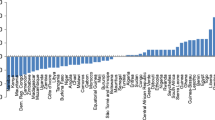Abstract
Most governments have an impressive record in their formal accession to the relevant international child rights treaties. But the extent of their commitment to children varies widely and the gap between promises and reality remains wide. In response, we, at The African Child Policy Forum, developed an approach to measure government performance in realising children’s rights and ensuring their wellbeing. The approach quantitatively measures how well governments are doing in meeting their national and international obligations to children through the Child-friendliness Index. This composite index is used to assess and rank the performance of all 52 African governments using a common set of indicators. It provides an indication of how prioritised children’s issues are in African governments’ policy agendas, and the extent to which those agendas are child-friendly. According to the Child-friendliness Index ranking, Mauritius and Namibia emerged as the first and second most child-friendly governments, respectively, in Africa. In addition to these two, the “most child-friendly governments” group consists of both countries with high economic performance as well as those with a low status. The analysis also showed that national wealth and a high level of development are not guarantees of child wellbeing. The results further indicated that change and progress towards ensuring child wellbeing are possible and feasible even at very low levels of development and calls for: (a) adoption and implementation of effective laws and policies; and (b) a policy of child budgeting that prioritises the needs of children.


Similar content being viewed by others
Notes
Correlation coefficient is a value that shows the strength of association or the tendency of the variables to increase or decrease together. Its value ranges from -1 to 1.
Relationship in which a change in one variable is accompanied by a change in the other, based on complex interaction rather than direct cause.
‘The Involvement of Children in Armed Conflict’ and ‘The Sale of Children, Child Prostitution and Pornography’.
References
African Child Policy Forum (2007). In the Best Interests of the Child: Harmonisation of laws in Eastern and Southern Africa. Addis Ababa.
African Child Policy Forum (2008). The African Report on Child Wellbeing 2008: How child-friendly are African governments? (Addis Ababa: The African Child Policy Forum).
Ainsaar, M., & Aidarov, A. (2003). Role of local governments in supporting families with children. Tartu: Tartu University.
Anand, S., & Sen, A. (1994). Human development index: Methodology and measurement. New York: Human Development Office.
Ben-Arieh, A., & George, R. (2001). Beyond the numbers: how do we monitor the state of our children? Children and Youth Services Review, 23(8), 603–631.
Booysen, F. (2002). An overview and evaluation of composite indices of development. Social Indicators Research, 59(2), 115–151.
Bradshaw, J., Hoelscher, P. and Richardson, D. (2006). Child Wellbeing in OECD Countries: Concepts and Methods, Working Paper No. 2006-03, Florence: UNICEF- Innocenti Research Centre.
Cahill, M. (2005). Is the human development index redundant? Eastern Economic Journal, 31(1), 1–5.
Economic Intelligence Unit (EIU) (2007). Methodology, Results and Findings, Global Peace Index, Cammeray; Accessed in October 2007 at www.visionofhumanityw.com.
McGillivray, M., & White, H. (1993). Measuring development? The UNDP’s human development index. Journal of International Development, 5(2), 183–192.
McGillivray, M., & Noorbakhsh, F. (2004). Composite indices of human wellbeing: Past, present and future. Helsinki: United Nations University, WIDER.
Mo Ibrahim Foundation (2007). Index of African Governance 2007, The Mo Ibrahim Foundation. Available at: http://www.moibrahimfoundation.or/index/overall.pdf.
Nardo, M., Saisana, M., Saltelli, A., Tarantola, S., Hoffman, A., & Giovannini, E. (2005). Handbook on constructing composite indicators: Methodology and user guide, working paper. Paris: OECD Statistics Directorate.
Office of the High Commissioner for Human Rights (OHCHR) (2007). Accessed in January 2009 at: http://www.ohchr.org.
Salzman, J. (2003). Methodological Choices Encountered in the Construction of Composite Indices of Economic and Social Wellbeing. Center for the Study of Living Standards.
Theis, J. (2003). Rights-based monitoring and evaluation: A discussion paper. Bangkok: Save the Children Alliance.
UNDP. (2000). Human development report 2000: Human rights and human development. New York: Human Development Office.
UNICEF. (2004). Building child-friendly cities: A framework for action. Florence: Innocenti Research Centre.
UNOHCHR. (2001). Training manual on human rights monitoring. Professional training series no.7. Geneva: OHCHR.
Wiesmann, D. (2006). A global hunger index: Measurement concept, ranking of countries, and trends, discussion paper. Washington: International Food Policy Research Institute.
William W. and Kane T. (2007). Methodology: Measuring the 10 Economic Freedoms, 2007 Index of Economic Freedom. The Heritage Foundation.
Author information
Authors and Affiliations
Corresponding author
Additional information
The African Child Policy Forum (ACPF)
is an independent pan-African policy research and advocacy centre based in Addis Ababa, Ethiopia. Its mission is to put children in Africa on the political and public agenda, focusing on the development and implementation of effective policies and laws. The work of the ACPF is rights-based, inspired by universal values, and informed by global experiences and knowledge. ACPF aims to provide opportunities for dialogue, to contribute to improved knowledge of the problems facing African children, to identify policy options, and to strengthen the capacity of NGOs and governments to develop and implement effective pro-child policies and programmes.
Appendices
Appendix 1a Spearman's Rank Correlation Matrix for Child-Outcome Indicators*
Appendix 1b Spearman's Rank Correlation Matrix for Budgetary Indicators
Appendix 1c Summary of Indicator Values for each Component That Make Up the Legal and Policy Dimension
Rights and permissions
About this article
Cite this article
Mekonen, Y. Measuring Government Performance in Realising Child Rights and Child Wellbeing: The Approach and Indicators. Child Ind Res 3, 205–241 (2010). https://doi.org/10.1007/s12187-009-9047-5
Accepted:
Published:
Issue Date:
DOI: https://doi.org/10.1007/s12187-009-9047-5



